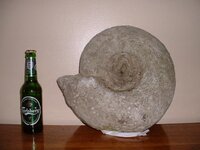- Joined
- Nov 19, 2002
- Messages
- 3,031
So there was I last night down the pub, as usual, listening to some terrible jazz, when this chap says to me: “Phil, I know you are interested in fossils. I’ve got a really large one in my shed. Do you want to see it?” Rather nervously accepting his offer, I went to his house at two in the morning, carried on drinking copious amounts of his lethal home-brewed cider and he gave me this enormous ammonite!
I got stopped by the police on the way home who asked me what on earth I was doing at half past four in the morning staggering around and carrying something gigantic and suspicious in a bag. I explained to the officer, in a half-cut sort of way, that it was a limestone ammonite of immense proportions. The officer looked somewhat perplexed and drove on, obviously thinking I was some sort of nutter.
Anyway, I have absolutely no idea what the species of ammonite actually is, and I would gratefully like to hear any suggestions. Unfortunately the person who gave it to me did not know either and did not know where it was found. All I can say is that it is preserved as limestone, came from the UK, has complex suture marks and has no keel. It is 13 inches across. I suspect it may be Jurassic, due to the lack of ornamentation, but I’m not exactly sure.
I got stopped by the police on the way home who asked me what on earth I was doing at half past four in the morning staggering around and carrying something gigantic and suspicious in a bag. I explained to the officer, in a half-cut sort of way, that it was a limestone ammonite of immense proportions. The officer looked somewhat perplexed and drove on, obviously thinking I was some sort of nutter.
Anyway, I have absolutely no idea what the species of ammonite actually is, and I would gratefully like to hear any suggestions. Unfortunately the person who gave it to me did not know either and did not know where it was found. All I can say is that it is preserved as limestone, came from the UK, has complex suture marks and has no keel. It is 13 inches across. I suspect it may be Jurassic, due to the lack of ornamentation, but I’m not exactly sure.



